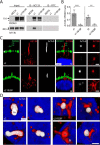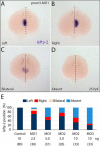Prominins control ciliary length throughout the animal kingdom: New lessons from human prominin-1 and zebrafish prominin-3
- PMID: 32201384
- PMCID: PMC7196652
- DOI: 10.1074/jbc.RA119.011253
Prominins control ciliary length throughout the animal kingdom: New lessons from human prominin-1 and zebrafish prominin-3
Abstract
Prominins (proms) are transmembrane glycoproteins conserved throughout the animal kingdom. They are associated with plasma membrane protrusions, such as primary cilia, as well as extracellular vesicles derived thereof. Primary cilia host numerous signaling pathways affected in diseases known as ciliopathies. Human PROM1 (CD133) is detected in both somatic and cancer stem cells and is also expressed in terminally differentiated epithelial and photoreceptor cells. Genetic mutations in the PROM1 gene result in retinal degeneration by impairing the proper formation of the outer segment of photoreceptors, a modified cilium. Here, we investigated the impact of proms on two distinct examples of ciliogenesis. First, we demonstrate that the overexpression of a dominant-negative mutant variant of human PROM1 (i.e. mutation Y819F/Y828F) significantly decreases ciliary length in Madin-Darby canine kidney cells. These results contrast strongly to the previously observed enhancing effect of WT PROM1 on ciliary length. Mechanistically, the mutation impeded the interaction of PROM1 with ADP-ribosylation factor-like protein 13B, a key regulator of ciliary length. Second, we observed that in vivo knockdown of prom3 in zebrafish alters the number and length of monocilia in the Kupffer's vesicle, resulting in molecular and anatomical defects in the left-right asymmetry. These distinct loss-of-function approaches in two biological systems reveal that prom proteins are critical for the integrity and function of cilia. Our data provide new insights into ciliogenesis and might be of particular interest for investigations of the etiologies of ciliopathies.
Keywords: ADP-ribosylation factor (ARF); ADP-ribosylation factor-like protein 13B (Arl13b); CD133; Kupffer's vesicle; MDCK; cilia; ciliopathy; cilium; development; left-right asymmetry; membrane polarity; membrane protein; prominin-1 (PROM1); zebrafish.
© 2020 Jászai et al.
Conflict of interest statement
The authors declare that they have no conflicts of interest with the contents of this article
Figures







Similar articles
-
Deletion of the transmembrane protein Prom1b in zebrafish disrupts outer-segment morphogenesis and causes photoreceptor degeneration.J Biol Chem. 2019 Sep 20;294(38):13953-13963. doi: 10.1074/jbc.RA119.008618. Epub 2019 Jul 30. J Biol Chem. 2019. PMID: 31362982 Free PMC article.
-
Arl13b Interacts With Vangl2 to Regulate Cilia and Photoreceptor Outer Segment Length in Zebrafish.Invest Ophthalmol Vis Sci. 2016 Aug 1;57(10):4517-26. doi: 10.1167/iovs.16-19898. Invest Ophthalmol Vis Sci. 2016. PMID: 27571019 Free PMC article.
-
Prominin-1 (CD133) modulates the architecture and dynamics of microvilli.Traffic. 2019 Jan;20(1):39-60. doi: 10.1111/tra.12618. Epub 2018 Nov 14. Traffic. 2019. PMID: 30328220
-
Molecular views of Arf-like small GTPases in cilia and ciliopathies.Exp Cell Res. 2013 Sep 10;319(15):2316-22. doi: 10.1016/j.yexcr.2013.03.024. Epub 2013 Mar 31. Exp Cell Res. 2013. PMID: 23548655 Free PMC article. Review.
-
The photoreceptor cilium and its diseases.Curr Opin Genet Dev. 2019 Jun;56:22-33. doi: 10.1016/j.gde.2019.05.004. Epub 2019 Jun 28. Curr Opin Genet Dev. 2019. PMID: 31260874 Review.
Cited by
-
Prominosomes - a particular class of extracellular vesicles containing prominin-1/CD133?J Nanobiotechnology. 2025 Jan 29;23(1):61. doi: 10.1186/s12951-025-03102-w. J Nanobiotechnology. 2025. PMID: 39881297 Free PMC article. Review.
-
Protrusion-Derived Extracellular Vesicles (PD-EVs) and Their Diverse Origins: Key Players in Cellular Communication, Cancer Progression, and T Cell Modulation.Biol Cell. 2025 Jun;117(6):e70018. doi: 10.1111/boc.70018. Biol Cell. 2025. PMID: 40500981 Free PMC article. Review.
-
Deciphering the impact of PROM1 alternative splicing on human photoreceptor development and maturation.Cell Death Dis. 2024 Oct 1;15(10):721. doi: 10.1038/s41419-024-07105-7. Cell Death Dis. 2024. PMID: 39353897 Free PMC article.
-
EV duty vehicles: Features and functions of ciliary extracellular vesicles.Front Genet. 2022 Aug 19;13:916233. doi: 10.3389/fgene.2022.916233. eCollection 2022. Front Genet. 2022. PMID: 36061180 Free PMC article. Review.
-
An Update on Molecular Pathways Regulating Vasculogenic Mimicry in Human Osteosarcoma and Their Role in Canine Oncology.Front Vet Sci. 2021 Sep 23;8:722432. doi: 10.3389/fvets.2021.722432. eCollection 2021. Front Vet Sci. 2021. PMID: 34631854 Free PMC article. Review.
References
-
- Weigmann A., Corbeil D., Hellwig A., and Huttner W. B. (1997) Prominin, a novel microvilli-specific polytopic membrane protein of the apical surface of epithelial cells, is targeted to plasmalemmal protrusions of non-epithelial cells. Proc. Natl. Acad. Sci. U.S.A. 94, 12425–12430 10.1073/pnas.94.23.12425 - DOI - PMC - PubMed
Publication types
MeSH terms
Substances
LinkOut - more resources
Full Text Sources
Molecular Biology Databases
Research Materials

